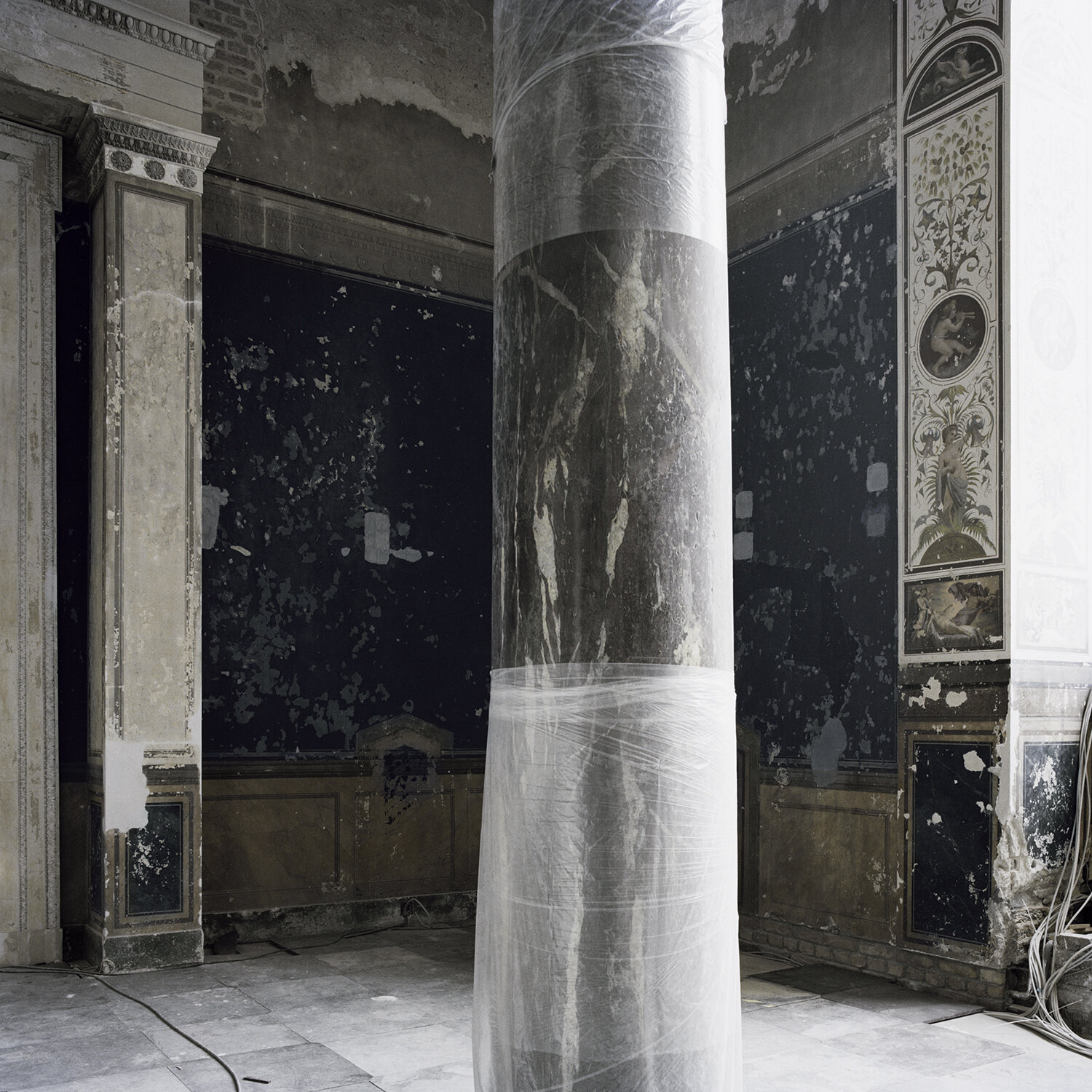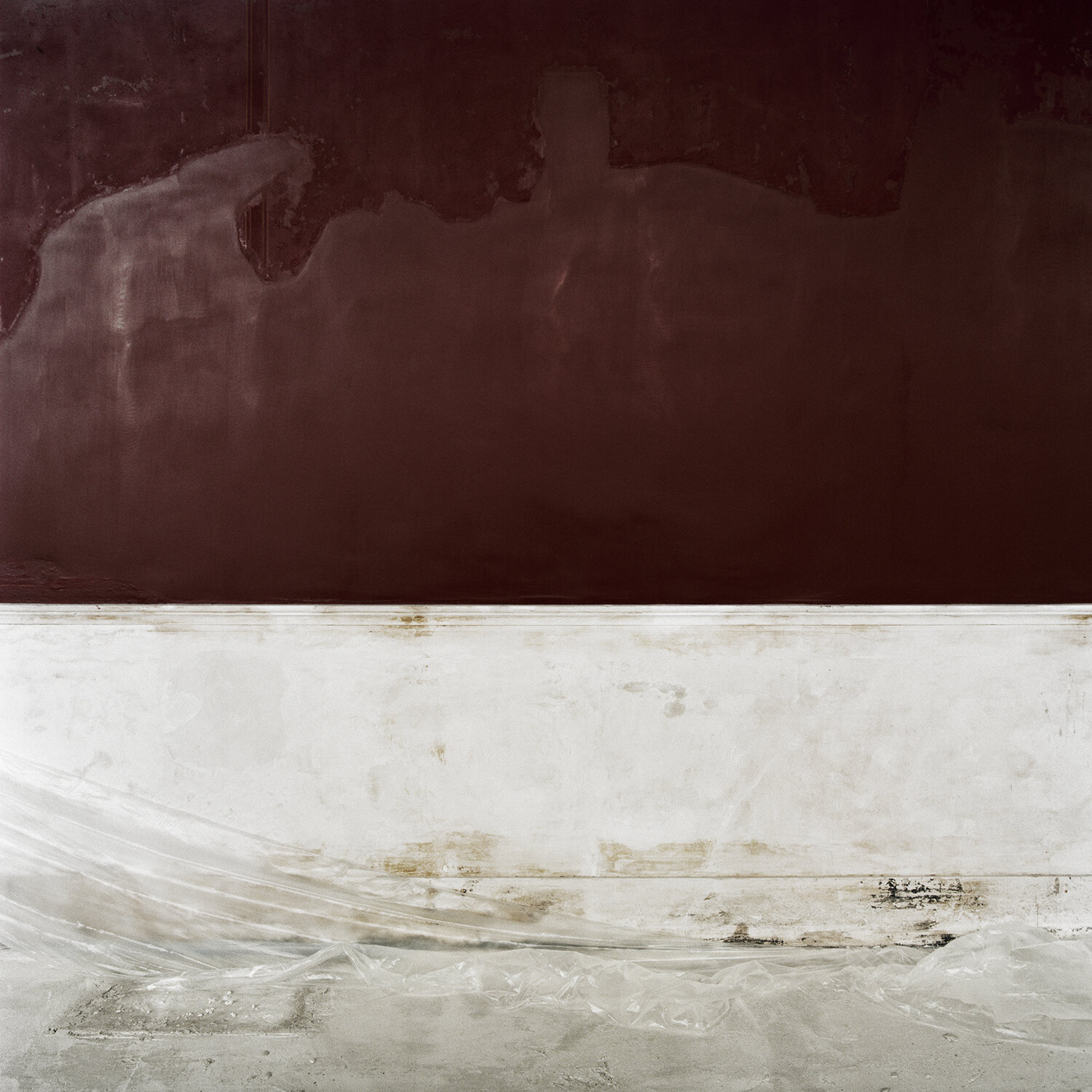Friederike von Rauch’s photographs of the Neues Museum in Berlin document its transition from a disused ruin into a living entity whose history is encoded in its structure. Made during the final phase of the museum’s long-awaited reconstruction, her meticulous compositions document spaces where the ephemeral and the enduring are knit together.
The Neues Museum houses Germany’s collections of Egyptian, prehistoric, and early historic art and artifacts. Constructed in 1855, the building, which embodies the ornate Neoclassicism of nineteenth-century state architecture, was severely damaged during the bombing of Berlin in World War II. After the war, the museum fell within the Soviet-occupied sector of the city, where it stood empty for decades. Through the Cold War years, plans to restore the museum moved forward in fits and starts, hampered by bureaucratic inertia and lack of funds.
There was nearly a decade of debate about the fate of the Neues Museum following Germany’s reunification. After the fall of the Berlin Wall, Germany’s national collections, which had been broken up during the country’s division, were consolidated. The scope of the museum’s collection expanded, and its restoration became a collaborative project between archeologists and curators from both East and West Germany. In a way, the restoration project became a microcosm of reunification, in all of its hopefulness and all of its complexity. The structure itself, which in its semi-ruined state had stood as a reminder of Germany’s defeat in the Second World War, began to be seen as a symbol of Cold War rapprochement. There was a growing consensus that the only successful rebuilding solution was one that would do justice to the Neues Museum’s layered history, which had become so bound up with Germany’s own.
Dienerkam
The reconstruction contract eventually awarded to the London-based firm David Chipperfield Architects was not for a traditional restoration, which would return the building to a simulacrum of its original state. Instead, Chipperfield and his team would perform what they called a “complementary restoration.” The surviving pieces of the building and its decorative elements would be stabilized and preserved, but where major areas of new construction were needed, no effort would be made to emulate the style of the past. New construction was completed in a restrained but distinctly contemporary idiom. Chips and gouges in the museum’s many elaborately painted frescoes were filled with plaster but left bone-white. New structural elements preserved the lines of the original neoclassical architecture in simplified form. As a result, the building’s character remains while its damaged areas have become defining architectural features.
The German author W. G. Sebald wrote that, when confronting a piece of monumental architecture, “At most we gaze at it in wonder, a kind of wonder which in itself is a form of dawning horror, for somehow we know by instinct that outsize buildings cast the shadow of their own destruction before them, and are designed from the first with an eye to their later existence as ruins.” Inverting Sebald’s logic, the rebuilt Neues Museum has been designed with an eye to its prior existence as a ruin. Its present form is suffused with history.
Niobidensaal
Photographs, in securing a bit of the present from the ravages of the future, bear a trace of that “dawning horror” that Sebald describes. In a way, an architectural photographer’s task is not so different from that of an architect restoring a building—she applies her craft to someone else’s work, preserving the character of the original construction for posterity while inflecting it with her own vision. Friederike von Rauch engaged in a sort of complementary representation, photographing in her distinct style while attending to the specificities of the site.
Von Rauch’s images are spare evocations of the museum in the final days before it was opened to the public in 2009. The major renovations have been completed, but the litter of construction remains. Matted braids of electrical cord hang lank from the walls. Plastic drop cloths shroud rawboned columns, or else lie crumpled on dusty floors. A section of bare, freshly plastered wall and a naked instrument panel coexist uneasily with an ornate Neoclassical mural. Von Rauch imposes geometric order onto the museum’s spaces, favoring right angles and anchoring her compositions with strong vertical and horizontal elements. From within these rigorously constructed containers, disorder escapes. In one image, an open window, swung inward into the room, becomes a flat-plane coordinate grid that by contrast dramatizes the spatial recession of the parqueted wall beneath it. In another nearly monochromatic photograph, a round, plastic-wrapped fixture—a wall clock?—becomes the meeting point for a set of interlocking planes, delimited by a spray of centripetal lines. A third composition is neatly bifurcated into areas of unevenly repainted red wall above and scuffed white molding and floor below. The wall’s visceral, mottled color and the sinewy swath of plastic drop cloth stretched across the floor are reminiscent of Heidi Buchler’s “skinnings”—filmy latex casts of parts of buildings, which the artist displayed hung like tapestries or stretched hides.
Vaterlaendischer Saal
In foregrounding the ephemeral by-products of the rebuilding process against the enduring precision of the building’s architecture, von Rauch emphasizes the bodily quality of a building that is often described in terms of its “scars.” She depicts the museum in the final stage of its healing process. These moments of incongruity give way to other contrasts, between the Baroque excess of the original architecture and the spare economy of the contemporary additions. Like the structure she has documented, the finely calibrated tension von Rauch finds in her images holds past and present in equilibrium.
This article first appeared in Issue 13, The Museum Issue.






